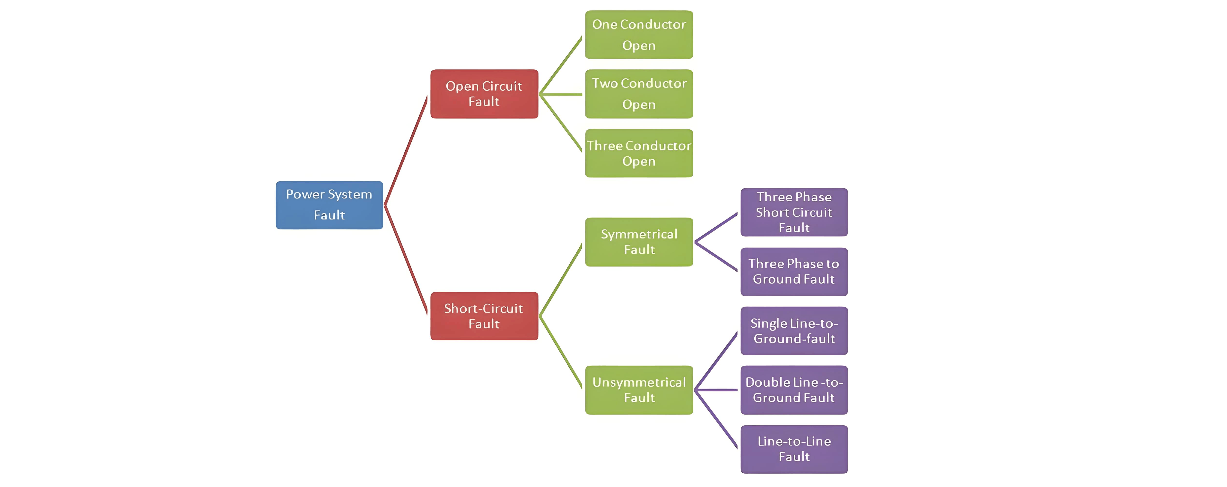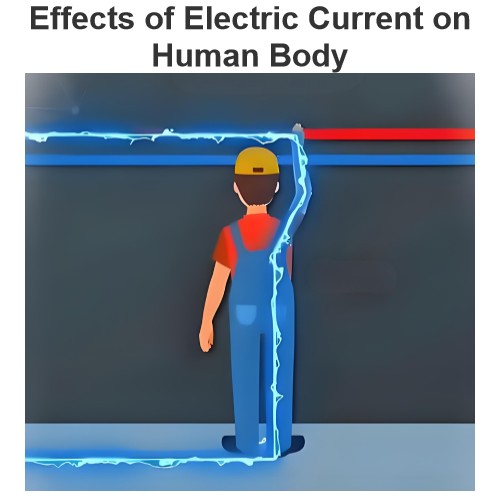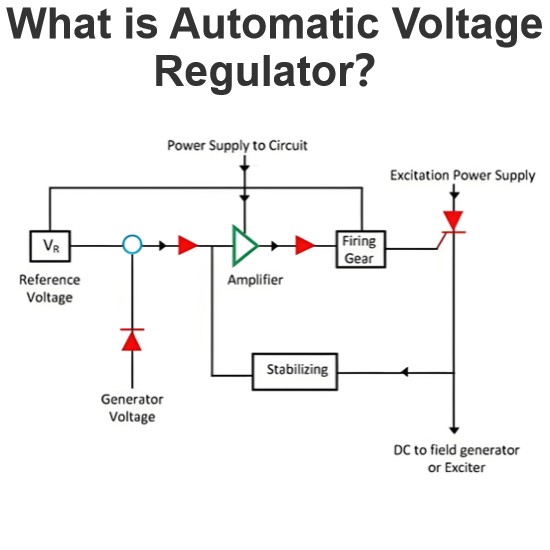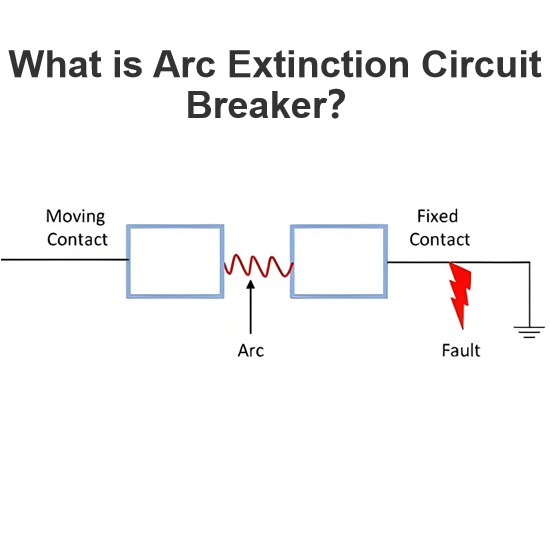Types of Faults in Power System
Power System Faults: Definition and Classification
A fault in a power system is defined as an anomaly or defect that causes the electric current to deviate from its intended flow path. When a fault occurs, it creates abnormal operating conditions, primarily by reducing the insulation strength between conductors. This degradation of insulation can lead to severe damage to the power system components, disrupt normal power supply, and pose safety risks.
Power system faults are primarily classified into two main types:
Open Circuit Fault: This type of fault occurs when there is a break or discontinuity in the electrical circuit, preventing the normal flow of current. It can result from damaged conductors, loose connections, or the failure of electrical components.
Short Circuit Fault: In a short - circuit fault, there is an unintended low - resistance path between two or more conductors, causing a large amount of current to flow. This can be due to insulation breakdown, physical contact between conductors, or equipment malfunctions.
The various subtypes and manifestations of these power system faults are illustrated in the image provided below.

Causes and Classification of Power System Faults
Power system faults can arise due to a multitude of natural disturbances. Events such as lightning strikes, high - velocity winds, and earthquakes can all trigger faults. Lightning, with its intense electrical discharges, can damage insulation and disrupt normal current flow. High - speed winds may topple power lines or cause conductors to sway and come into contact with other objects, while earthquakes can displace infrastructure, leading to broken conductors and damaged electrical components.
Faults can also be the result of various accidents. For instance, a tree falling onto power lines, a vehicle colliding with a supporting structure, or an aeroplane crashing into electrical infrastructure can all lead to disruptions in the power system. These accidental events can directly damage conductors, insulators, or other vital parts of the electrical network, causing faults to occur.
1. Open Circuit Fault
An open circuit fault predominantly occurs when one or two conductors fail. Since this type of fault occurs in series with the electrical line, it is also known as a series fault. Open circuit faults have a significant impact on the reliability of the power system, often leading to disruptions in power supply and potential damage to connected equipment.
Open circuit faults can be further categorized into the following types:
Open Conductor Fault: This occurs when a single conductor in the electrical circuit breaks or becomes disconnected, disrupting the flow of current through that particular path.
Two Conductors Open Fault: In this scenario, two of the conductors in the system fail, creating a more severe disruption to the electrical flow. This type of fault can lead to unbalanced conditions and may cause additional stress on the remaining components of the system.
Three Conductors Open Fault: The rarest and most severe form of open circuit fault, it involves the failure of all three conductors in a three - phase system. This results in a complete loss of power transmission and can have far - reaching consequences for the electrical grid and connected loads.
The different configurations of open circuit faults are illustrated in the figure below, providing a visual representation of how these faults manifest within the power system.

2. Short - Circuit Fault
A short - circuit fault occurs when conductors from different phases make contact with each other within a power line, power transformer, or other circuit elements. This unintended connection causes a substantial amount of current to flow through one or two phases of the electrical system. Short - circuit faults can be further classified into two main categories: symmetrical and unsymmetrical faults.
Symmetrical Fault
Symmetrical faults are those that involve all three phases of an electrical system. Remarkably, these faults maintain a state of balance even after the fault event occurs. Symmetrical faults predominantly take place at the terminals of generators. The initiation of such faults can be attributed to various factors, such as the resistance of the electric arc formed between conductors during the fault or the presence of low footing resistance in the grounding system.
Symmetrical faults are sub - categorized into two distinct types: line - to - line - to - line fault and three - phase line - to - ground fault.
a. Line – Line – Line Fault
Line - to - line - to - line (L - L - L) faults are characterized by their balanced nature. Even after the fault occurs, the electrical system retains its symmetry. While relatively rare, L - L - L faults are among the most severe types of short - circuit faults. They generate the largest fault currents within the system, which play a crucial role in determining the rating requirements of circuit breakers. The ability of circuit breakers to interrupt these extremely high - magnitude currents safely and effectively is directly informed by the characteristics of L - L - L faults, making them a key consideration in power system design and protection.

b. L–L–L–G (Three - phase Line - to - Ground Fault)
A three - phase line - to - ground (L–L–L–G) fault encompasses all three phases of the electrical system. In this fault scenario, a connection is established between all three phases and the system's ground. Although less common compared to some other fault types, the L–L–L–G fault holds significant importance in power system analysis. Statistically, the likelihood of such a fault occurring is approximately 2 to 3 percent. This relatively low probability notwithstanding, when an L–L–L–G fault does occur, it can generate substantial fault currents and cause widespread disruptions to the power system, necessitating robust protective measures and careful consideration in system design and operation.

Unsymmetrical Fault
An unsymmetrical fault is defined as a condition in the power system that generates unsymmetrical currents, where the magnitudes and phases of the currents in the three phases differ significantly from one another. This type of fault typically involves one or two phases, such as line - to - ground (L - G), line - to - line (L - L), or double line - to - ground (L - L - G) faults. As a result of these faults, the electrical system becomes unbalanced, which can lead to a variety of operational issues and potential damage to equipment.
Unsymmetrical faults can be mainly classified into three distinct types:
Single Line - to - Ground (L – G) Fault
Line - to - Line Fault (L – L)
Double Line - to - Ground (L – L – G) Fault
Among all types of power system faults, unsymmetrical faults are the most commonly occurring.
1. Single Line - to - Ground (L – G) Fault
A single line - to - ground fault happens when one of the conductors comes into contact with the ground or touches the neutral conductor. This type of fault is extremely prevalent, accounting for a staggering 70 - 80 percent of all faults that occur within power systems. Its high frequency of occurrence makes it a critical concern for power system operators and engineers, who must implement effective protective measures to mitigate its potential impacts on system stability and reliability.

3. Double Line - to - Ground (L - L - G) Fault
In a double line - to - ground fault, two conductors simultaneously make contact with each other and the ground. This fault scenario creates a complex electrical path that disrupts the normal operation of the power system. While less common than single line - to - ground faults, double line - to - ground faults still pose significant risks to system stability and equipment integrity. Statistically, the likelihood of a double line - to - ground fault occurring is approximately 10% of all power system faults. This relatively low but non - negligible probability underscores the importance of incorporating comprehensive protection and mitigation strategies within power systems to safeguard against the potential damage and operational disruptions caused by such faults.

The Electricity Encyclopedia is dedicated to accelerating the dissemination and application of electricity knowledge and adding impetus to the development and innovation of the electricity industry.













